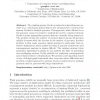Free Online Productivity Tools
i2Speak
i2Symbol
i2OCR
iTex2Img
iWeb2Print
iWeb2Shot
i2Type
iPdf2Split
iPdf2Merge
i2Bopomofo
i2Arabic
i2Style
i2Image
i2PDF
iLatex2Rtf
Sci2ools
WABI
2009
Springer
2009
Springer
Decoding Synteny Blocks and Large-Scale Duplications in Mammalian and Plant Genomes
Abstract. The existing synteny block reconstruction algorithms use anchors (e.g., orthologous genes) shared over all genomes to construct the synteny blocks for multiple genomes. This approach, while efficient for a few genomes, cannot be scaled to address the need to construct synteny blocks in many mammalian genomes that are currently being sequenced. The problem is that the number of anchors shared among all genomes quickly decreases with the increase in the number of genomes. Another problem is that many genomes (plant genomes in particular) had extensive duplications, which makes decoding of genomic architecture and rearrangement analysis in plants difficult. The existing synteny block generation algorithms in plants do not address the issue of generating non-overlapping synteny blocks suitable for analyzing rearrangements and evolution history of duplications. We present a new algorithm based on the A-Bruijn graph framework that overcomes these difficulties and provides a unifie...
Algorithms | Genomes | Multiple Genomes | Synteny Block | WABI 2009 |
| Added | 25 May 2010 |
| Updated | 25 May 2010 |
| Type | Conference |
| Year | 2009 |
| Where | WABI |
| Authors | Qian Peng, Max A. Alekseyev, Glenn Tesler, Pavel A. Pevzner |
Comments (0)

